Our best rhubarb jam recipe with rose. Discover how to thicken it with less sugar and consequently more flavour, with or without pectin.
Plus, if your rhubarb is too green, follow my simple trick with natural hibiscus flowers.
Jill, thank you so much for this fabulous recipe. It was my first time making jam with rhubarb, and your directions are spot on. I especially love the extra touch of adding rose water. And low sugar and no pectin are exactly what I was looking for. My jam came out so well.
Dana
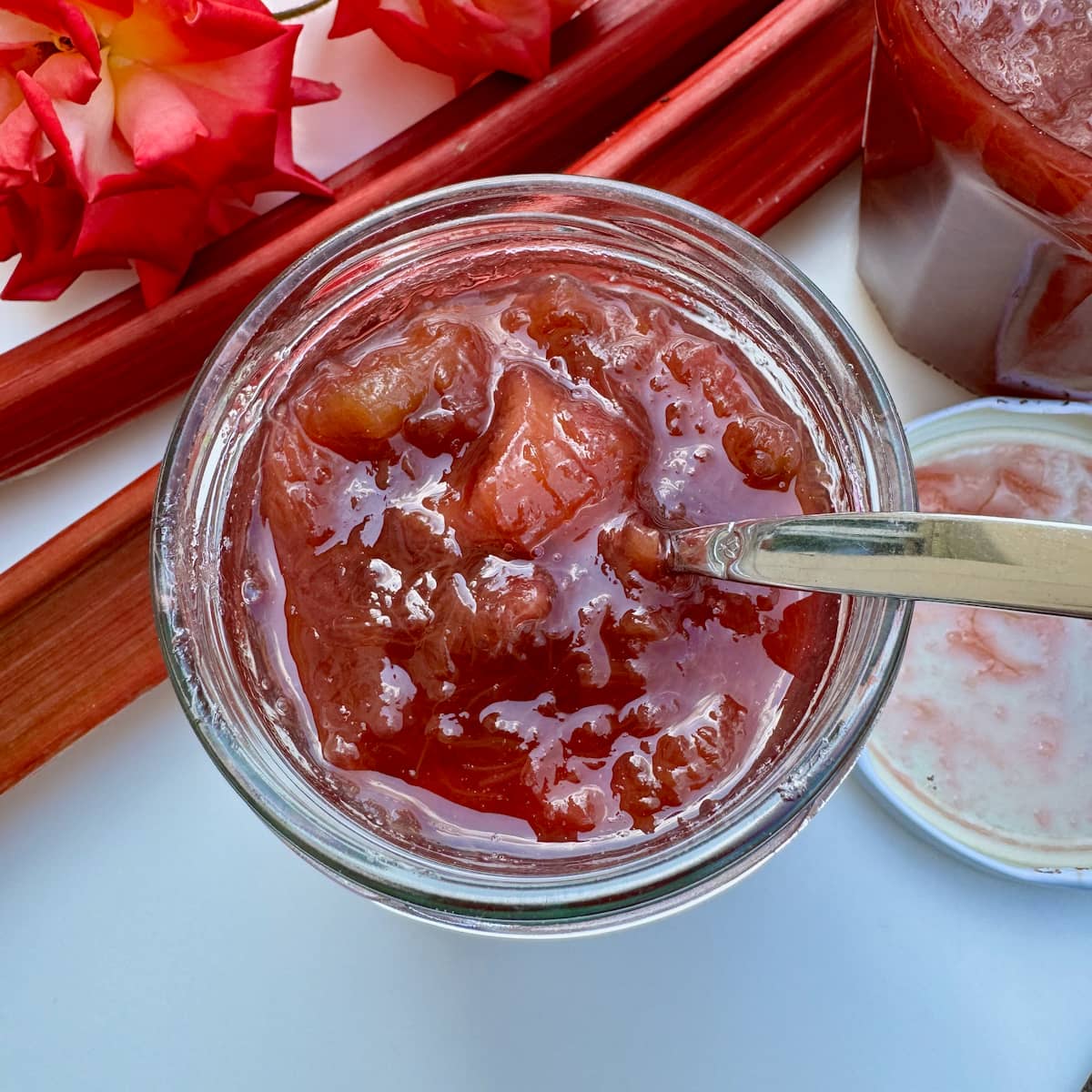
Rhubarb Jam Ingredients
We love this rhubarb jam simply because it's natural and packed with flavour. This recipe uses fresh, organic rhubarb (the more pink the better), sugar, lemon juice and a little rosewater. The rose just enhances the rhubarb but, if you prefer, it's just as good without. No water is added; we want the full flavour of rhubarb!
What's more, it's lower in sugar than classic recipes - as much as possible so we can still call it jam.
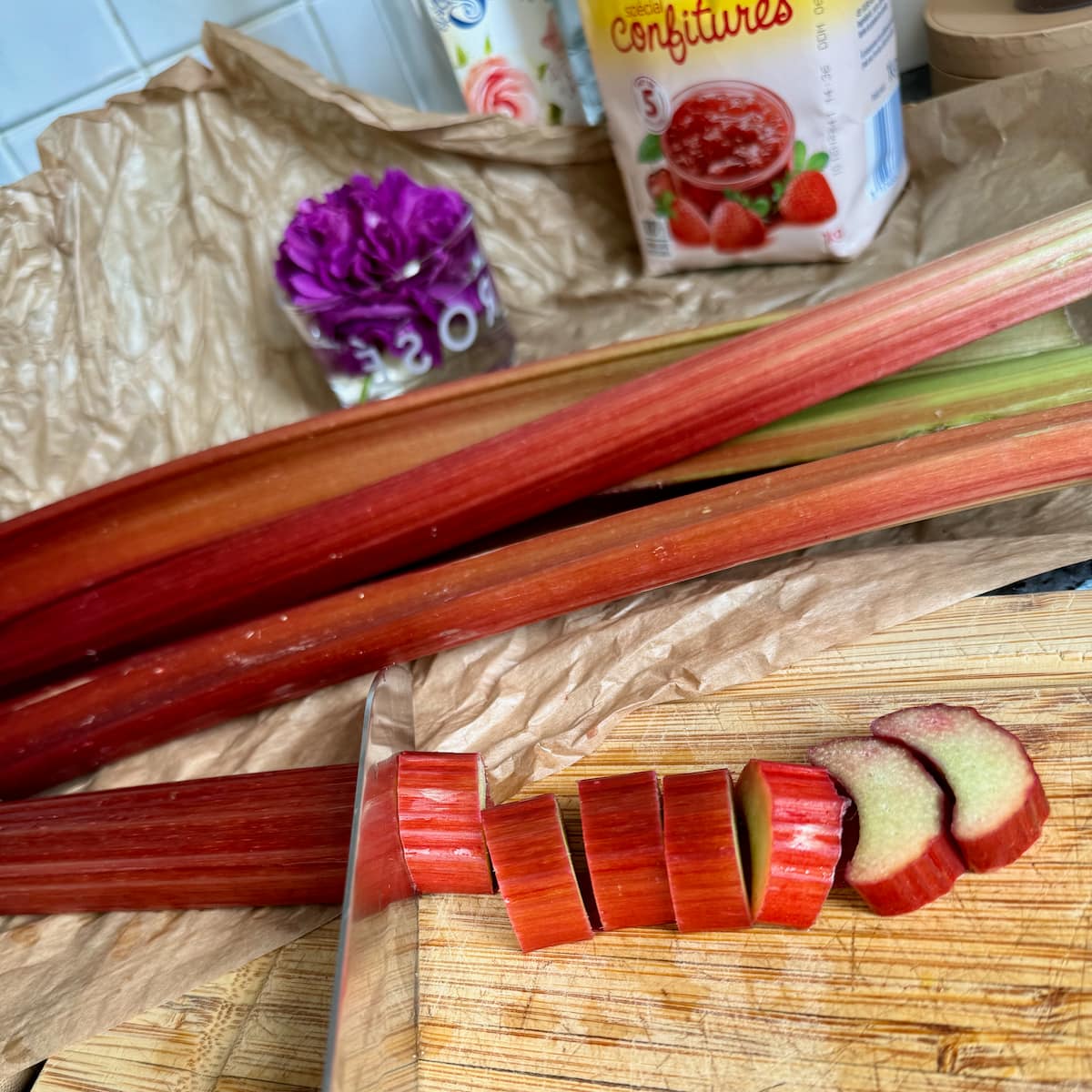
Is Rhubarb High or Low in Pectin?
Rhubarb, like strawberries, is low in pectin so it does need a helping hand to thicken jam.
How to Thicken Rhubarb Jam: Pectin or No Pectin?
With Pectin - in France, pectin isn't easily available in our supermarkets, but special pectin sugar (labelled, 'sucre pour confitures') for jam-making is easy to find.
However, check the ingredients on the special preserving jam sugar, as some brands have surprising, unnecessary ingredients - including oils! So, use a good quality pectin sugar that contains just sugar and pectin.
No Pectin - if you don't have pectin sugar, it's just as easy to add pectin naturally. Use normal granulated sugar but add the acidic juice and lemon rind/pulp while macerating. It also works well with oranges, as both citrus fruits are high in pectin.
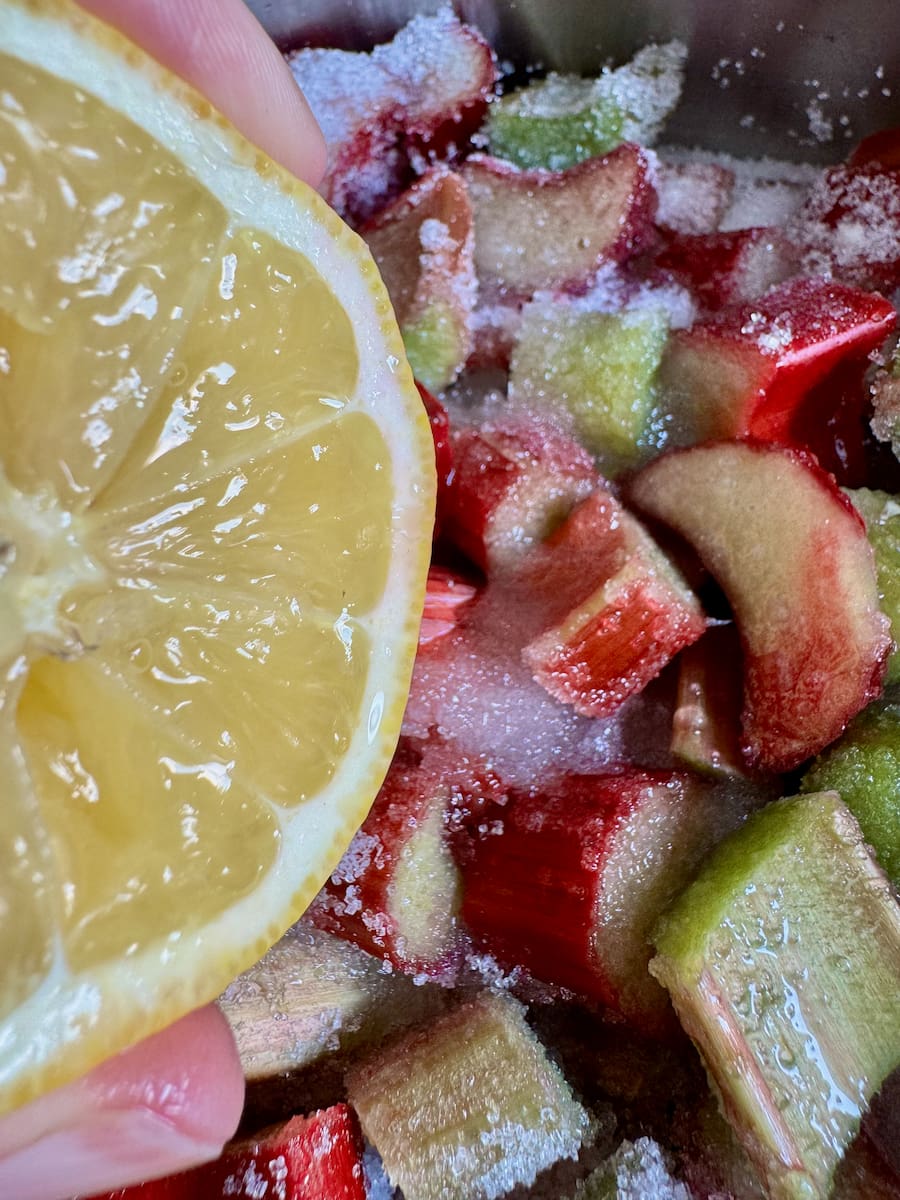
How Much Sugar for Rhubarb Jam?
Normally I use the least amount of sugar in jam making. In order for it to be called jam, the amount of sugar (including the sugar from the fruits) has to be 650g per kilo of fruit.
With naturally tart rhubarb, 600g (1.25 lb) is minimum to compensate for its tartness. Sugar is also reduced thanks to maceration. More on this below.
For more on sugar ratio to jam, see my recipe for Corsican Fig Jam - as it all depends on the type of fruit used. Some have more sugar, some more pectin, so it's a matter of judging between the two.

How to Make Rhubarb Jam
First wash, trim and cut medium slices of rhubarb.
Place in a pan with pectin sugar, lemon juice and a little rosewater, if using. (If you prefer without pectin, add the rest of the lemon rind and pulp.)
Leave to macerate, covered at room temperature, for about 2 hours or overnight, until the sugar and rhubarb juices turn liquid.
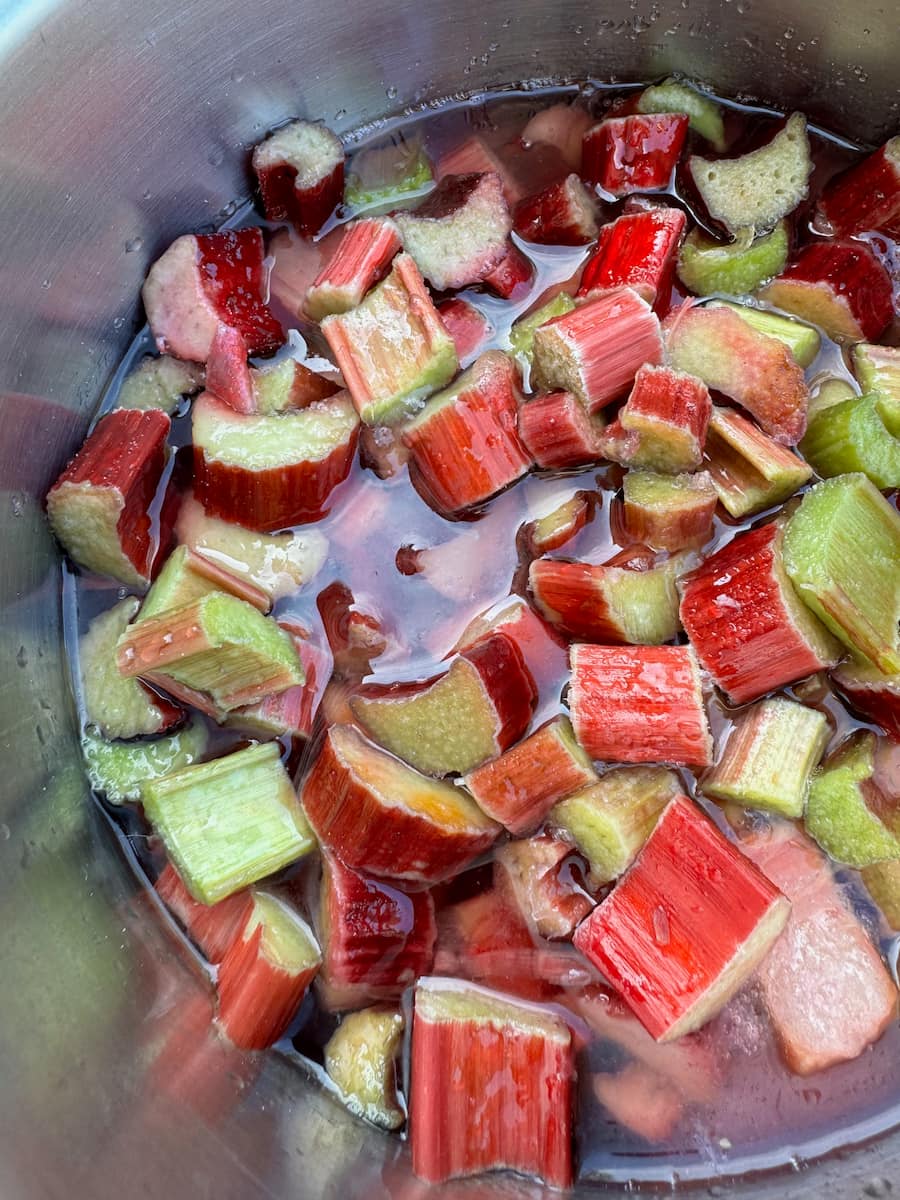
Why Macerate Fruit for Jam?
As I mentioned on the sugar content, we can reduce it thanks to maceration. By macerating the rhubarb in sugar at room temperature for a couple of hours, it extracts the natural liquid in the rhubarb. The result means less cooking time, less foam, plus no need to over boil and lose all these precious flavours.
I do this for all my jams, such as this apricot jam, as it means the jam preserves more of its natural fruit flavour. It may look long to leave it for 2 hours but it's worth the wait!
How to Sterilise Jam Jars
While the rhubarb is macerating, sterilise your jars and lids. There are 2 easy ways to do this, after washing them in hot, soapy water:
- Boil in a large pan of water for 2-3 minutes.
- Heat in the oven at 180°C/160°C fan (360°F/Gas 4)

After macerating, stir the rhubarb with the liquid and put on a medium-high heat for 15 minutes. Skim off any little scum there may be then lower the heat and simmer to thicken. This is for a further 30 minutes max.
Once transferred to the sterilised jars, seal by turning upside down or plunge into a water bath. Once the jars are cool, label and store in a cool, dry place for up to a year.

Red vs Green Rhubarb
A few years ago, I found a solution to green rhubarb found at our local French market. I didn't want to add strawberries to give it a pink look. Instead I wanted JUST the rhubarb. So I experimented with the addition of dried hibiscus flowers (carcadé) or hibiscus and red fruit infusions to this Rhubarb compote. Bingo! It worked.
Not only did it look much prettier red or deep pink, but it also tasted fabulous. The addition of hibiscus gives it that natural red plus, as it's also quite a bitter flavour, it actually enhances the delicious taste of rhubarb.
Just add 2 tablespoons while macerating (in a tea filter bag/cheesecloth) and remove after the first 15 minutes of heating.
What to do With Lots of Rhubarb?
If you're lucky enough to have plenty in season, then I have many more rhubarb recipes to enjoy them. As a Scot who grew up with rhubarb in Edinburgh, let's say the love for the stuff is in our blood! Try it with flavour combinations such as ginger, with orange, with strawberries, with the hibiscus, and rose.
For more on its preparation, facts and recipes,
see the French market produce guide to rhubarb.

How to Serve Rhubarb Jam
Rhubarb jam is perfect for a typical French breakfast: with a tartine of buttered sliced baguette. It's also an ideal topping for crêpes, Scotch pancakes and with fluffy brioche. Fill macaroon jam tarts or add a dollop on some French rice pudding.
Alternatively, serve with almond milk rice pudding for the ultimate vegan treat.
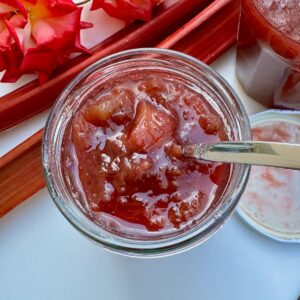
Rhubarb Jam with Rose
Equipment
- 3 sterlised jam jars with lids
Ingredients
- 1 kg (2lb 3oz) rhubarb stalks organic
- 600 g (1¼lb) sugar with pectin (or granulated sugar)
- 2 tablespoon lemon juice or juice from a lemon (See NOTES)
- 1 teaspoon rose water
- 2 tablespoon dried hibiscus flowers (carcadé or hibiscus teabag) OPTIONAL, if your rhubarb is green
Instructions
- Wash, discard the end stems with any trace of leaves and cut the rhubarb into medium slices.
- Weigh the rhubarb in a large heavy-based pan and add the sugar, lemon and rosewater (SEE NOTES on green rhubarb). Cover and leave the rhubarb to macerate in the sugar for about 2 hours or overnight at room temperature, until the sugar dissolves and liquid extracted from the rhubarb.
- Meanwhile, sterilise 3-4 jam jars to ensure they are spotlessly clean. Steep and boil in a pan of water for 2-3 minutes and set aside to dry on a clean kitchen towel.
- Stir well then heat on medium-high for about 15 minutes. Skim off any slight trace of foam (macerating helps reduce this) and remove lemon pulp, if using. Turn down the heat slightly (don't boil as will destroy the flavours) and leave to simmer for about 30 minutes, stirring occasionally, until the jam thickens.
- When thick enough, spoon the hot jam into the sterilised jars as much as possible to the top, and tightly close the lids to seal. Turn the jars upside down until cool or seal them by plunging in a water bath.
Notes
Great as a rhubarb and rose filling for pink macaron shells. NUTRITIONAL INFORMATION: 250 Calories per ¼ of a pot.
This recipe was first published May 11th, 2017 but is now completely updated






Dana
Jill, thank you so much for this fabulous recipe. It was my first time making jam with rhubarb, and your directions are spot on. I especially love the extra touch of adding rose water. And low sugar and no pectin are exactly what I was look for. My jam came out so well. Thank you!
Jill Colonna
Thrilled to hear this, Dana. Thanks so much for taking the time to review. I bet you had a gorgeous aroma through the house!
Liz
Our rhubarb tends to be on the green side, too, so love this tip! I grew up with a big rhubarb patch in our back yard---I love all things rhubarb and your jam looks fabulous!! xo
Jill Colonna
What an idyllic childhood with garden rhubarb, Liz. Hope you try this, even if it's not that green since the taste is delicious.
Lainie
Hi Jill, I am very interested in this as we grow a lot of rhubarb. Why don't you cook your filled jars in a water bath after to preserve them? Does the sugar mean one could skip this step? Thanks, Lainie
Jill Colonna
Hi Lainie, how lucky that you grow rhubarb! Sterilising the jars first are the most important although, since this post, I now also give the jars a water bath after sealing, although not compulsory.